[Trade Journal]
Publication: Electrical World
New York, NY, United States
vol. 7, no. 17, p. 186, col. 1-3
Insulating Overhead Wires.
BY DAVID BROOKS.
An experience of forty years in the manufacture of insulators for telegraph lines should enable one to know something of the subject, though that does not necessarily follow. For the past twenty years I have made the matter of a perfect insulator in rain and fog, a study, and the present remarks will embrace the results of these investigations.
The first insulator I ever saw was in October, 1845, coming from Rochester to Albany on the Erie Canal. The New York Central Railway was then in course of construction and some portions in operation. In many places it ran parallel with the canal. Upon the line of the railway I noticed the first telegraph poles having a cross-arm with two insulators, but no wires. The line of telegraph was then in process of construction. In the late edition of Mr. Reid's "Telegraph in America," there is a good representation of that insulator, Fig. 1.
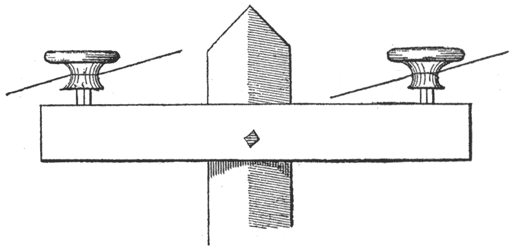 |
| Fig. 1. |
When in Rochester I engaged with Henry O'Reilly to come to Pennsylvania and assist him in the construction of telegraph lines. He was to write me when I should be needed, and I received due notice to come to Philadelphia, where I arrived on the 25th of November, 1845. After staying with Mr. O'Reilly in the city a few days, I proceeded to Lancaster, and found he had constructed a line between Lancaster and Harrisburg with one copper wire. The insulation consisted of a turned walnut pin two inches in diameter inserted in an auger hole; on the end of this pin was wound a strip of oil-cloth, and the copper wire was made to take one or two turns over the cloth. A representation of this fixture is shown in Fig. 3, from the same book. The first.message passed over this line Dec. 25, 1845. We could not work it except in favorable weather. In rain all operations ceased; besides, the copper wire broke as often as twice a day. In the following spring I removed the wire, took it to Philadelphia and sold it for old copper. During the following summer we constructed a line between Lancaster and Philadelphia, and used a three-ply twisted iron wire with an insulator, shown by Fig. 3 (from Reid). This insulator broke so often we were obliged to abandon it, and in its place used the insulator shown in Fig. 4. Carpenters set a ladder by the side of the pole, went to the top and mortised out a trough or groove :to admit this glass block, which carried the wire in the slot shown, and over the whole there was nailed a wood cap or cover to protect the insulator from rain. This last insulation was used from Philadelphia to Pittsburgh, but the ground being very uneven, the wire would get out of the groove and rest upon the pole or the cap wherever the pole stood in a hollow. We could not work the wire in rain. In the course of a year or two we put up the second wire from Philadelphia to Harrisburg, using a cross-arm insulator, as shown in Fig. 5. The hook was fastened in the glass by the use of brimstone. The brimstone would check or crack, absorb moisture and swell sufficient to split the glass, and the hooks were continually falling out. Here was my first attempt to remedy this difficulty. It was to mold the glass into an iron shield and insert the hook in the centre while the glass was in a molten state. The hook was very securely fastened in the glass, but the iron and glass did not shrink and expand together. The glass became full of cracks or fractures, which admitted moisture between the hook and iron shield. I soon got the credit of making the poorest insulator that ever existed. The difficulty was in a measure overcome by taking the wire out of the hook and suspending it from the hook by tarred rope. We went on making these insulators, and improved them to some extent by immersing them in hot spermaceti.
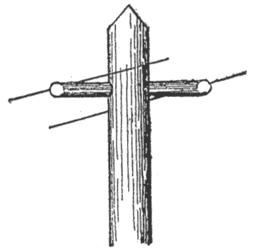 |
| Fig. 2. |
While this operation was going on, I came across a block or cake of paraffin, which was then a substance brought to notice as one of the results of the discovery of oil in Western Pennsylvania. There was no intention on my part to go into the manufacture of an insulator, but
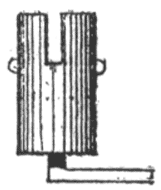 |
| Fig. 3. |
I desired some means to so improve it as to make it fit a hole bored in the cross-arm, and at the same time accomplish the purpose of insulation. Finding that glass could not be molded into an iron shield and the hook be inserted in the glass while the latter was in a molten state, without the glass becoming full of fractures that would admit moisture, I had the glass cast separately in a mold, fastened
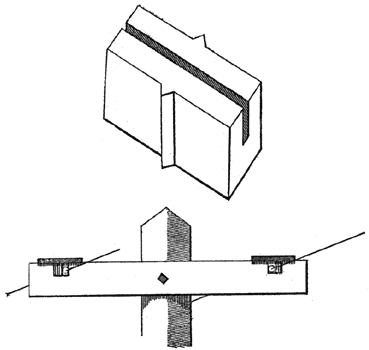 |
| Fig. 4. |
the hook into the glass with sulphur, and the glass into the iron shield by the same means; and in that manner I obtained a very perfect insulator. In the construction of new lines we used this insulator altogether, and experienced no difficulty in the most protracted wet weather. We put up two new wires from Pittsburgh to Reading, and there connected with two wires of the
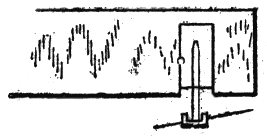 |
| Fig. 5. |
American Telegraph Company, insulated in the same manner to New York, and these wires were worked from New York to Pittsburgh, at full speed in the hardest rains, when the wires of the American lines could be worked from New York to Washington only by the use of repeaters at Philadelphia. The working of these wires, Nos. 12 and 20, gave a reputation to the insulators that soon brought them into demand in other places. Through the agency of L. G. Tillotson & Co., a great many were sent to South America, Newfoundland and other foreign countries. Meantime, I had obtained a patent on the use of paraffin for insulating purposes, and the insulator became known as the "Brooks Paraffin Insulator."
Experimenting with paraffin, I found its notable feature to be its repellance of moisture. You cannot produce a wet surface upon it. The moisture will gather itself into detached and isolated globules. Other bodies possess this property, but not in so marked a degree. In many of the restaurants there are water decanters, and on the inner surface about the neck of these bottles, you will notice the water in detached and isolated globules. Knowing that the outer surface of the glass of a bottle cast in a mold is nothing like as smooth as the inner surface which comes in contact with nothing but the air in the process of blowing, I found by experiment that the inner surface of a bottle possessed great insulating properties, and I at once went to work, and had the glass parts so made that they could be used to great advantage in the iron shield, and that is the basis now of the Brooks insulator.
In 1867 I resigned my position as superintendent of the telegraph lines at Philadelphia, and gave my whole attention to the manufacture of insulators. I first took a trip to Europe, to see what was being done in that line in the old countries.
